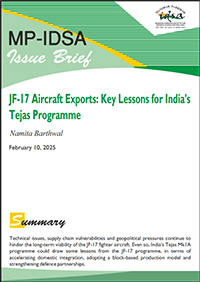JF-17 Aircraft Exports: Key Lessons for India’s Tejas Programme
- February 10, 2025 |
- Issue Brief
Summary
Technical issues, supply chain vulnerabilities and geopolitical pressures continue to hinder the long-term viability of the JF-17 fighter aircraft. Even so, India’s Tejas Mk1A programme could draw some lessons from the JF-17 programme, in terms of accelerating domestic integration, adopting a block-based production model and strengthening defence partnerships.
Introduction
China has played an instrumental role in Pakistan’s military modernisation. Their military cooperation includes joint military exercises on land, air and sea, along with the co-production of defence systems. Their military collaboration goes beyond standard defence agreement but stops short of a formal alliance.[1] One notable example is the joint production of the JF-17 aircraft by China’s Chengdu Aircraft Corporation (CAC) and Pakistan’s Aeronautical Complex (PAC) located in Kamra. JF-17 is a lightweight, multi-role fighter aircraft.
The development of JF-17 (previously known as FC-1 Xiaolong) began in China in the 1980s. The prototype of JF-17 was rolled out in 2003.[2] While it is marketed under Pakistan’s designation, CAC provides components, technology and design, whereas PAC oversees assembly, avionics integration and quality control[3] to complete the production process. Presently, Pakistan builds 58 per cent of the aircraft and China builds the remaining 42 per cent.[4]
Pakistan has actively marketed JF-17, which has three variants—Block I, Block II and the latest Block III. In 2024, the latest Block III model was showcased in Azerbaijan,[5] Saudi Arabia,[6] Bahrain[7] and Pakistan[8]. The aircraft market is targeted at countries in South Asia, Southeast Asia, West Asia and Sub-Saharan Africa. Over time, it has positioned itself as an affordable option to replace ageing fleets of aircraft such as the MiG-21 and older MiG-29 models.[9] JF-17 has captured a niche market. However, in the coming years, it will face competition from India’s Tejas, Turkey’s TF Kaan and South Korea’s KF-21.[10] This Brief analyses the JF-17 programme and identifies key takeaways that could guide India in advancing its indigenous Tejas Mk1A in the international defence sector.
JF-17 Defence Market
JF-17 aircraft has primarily been deployed for counter-insurgency and counter-terrorism operations,[11] as well as engagements against less advanced adversaries. To date, four countries—Azerbaijan, Myanmar, Nigeria and reportedly Iraq—have procured the JF-17 for these purposes (see Table 1). Pakistani media has reported that Bangladesh[12] and Iran have recently expressed interest[13] in acquiring the aircraft. However, negotiations with Iran may prove challenging, given Pakistan’s previous use of JF-17s in operations against insurgents in Iranian territory, which could complicate discussions.[14]
Table 1. JF-17 Purchases
| S.No. | Country | Number of JF-17 aircraft | Year of First Delivery | Deal (in USD) |
| 1 | Pakistan | 158 | 2007 | N/A |
| 2 | Myanmar | 16 | 2018/2019 | USD 25 million each |
| 3 | Nigeria | 3 | 2021 | USD 184 million |
| 4 | Azerbaijan | 8 | – | USD 1.6 billion |
| 5 | Iraq | 12 | – | USD 664 million |
Source: “Arms Transfers Database“, Stockholm International Peace Research Institute (SIPRI); “Pakistan’s JF-17 Thunder Makes Its Mark on the Global Arms Market“, AzerNews, 23 February 2024; “Pakistan’s JF-17 Thunder Ready for Export“, Dawn, 12 June 2015; Tony Osborne, “Pakistan Confirms JF-17 Sale to Azerbaijan“, Aviation Week, 26 September 2024; “Nigerian Air Force to Take Deliveries of M-346 by Year’s End“, Aviation Week, 19 April 2024.
There are four reasons behind the success of the JF-17 programme in securing contracts, especially for a relatively new and smaller-scale aircraft in an intensely competitive market. First is China’s backing, which now carries significant political, military and economic clout in the international system. Second, Pakistan has committed to making JF-17 the backbone of its air force, inducting a significant number of these aircraft[15] (see Table 1). This large-scale induction has helped craft a positive narrative around the aircraft’s capabilities, reassuring potential buyers about its reliability. This has also assured the PAC and CAC of sufficient orders to sustain the programme.
Third, JF-17 offers flexible purchasing terms, free from the strategic alignment requirements often imposed by Western manufacturers. These factors make it particularly appealing to countries with weaker ties to major global arms suppliers (the Western countries) and those seeking to develop indigenous aerospace capabilities.[16] Pakistan has marketed JF-17 to a variety of regimes, including authoritarian regimes like Azerbaijan, Myanmar, Iran and Saudi Arabia.
Fifth, one of the jet’s competitive advantages lies in its ability to fill the void created by the shrinking Russian defence market. Sanctions on Moscow have disrupted Russia’s ability to meet procurement timelines and deterred potential buyers due to the risk of secondary sanctions.[17] However, despite its competitive pricing and strategic flexibility, JF-17 has struggled with persistent criticisms regarding its technical and operational reliability.[18] This criticism from its client (Myanmar) has tarnished its reputation, leading to a noticeable decline in interest from potential buyers and making it a one-off purchase product.[19]
Technical and Geopolitical Challenges for JF-17
JF-17 fighter aircraft has faced numerous setbacks related to engine performance, structural deficiencies, radar systems and political dynamics with its Western counterparts, which have collectively hindered its operational efficacy and global standing.
The Myanmar Air Force (MAF), one of the earliest international operators, identified airframe vulnerabilities, including cracks in wingtips and hardpoints.[20] These issues led to the MAF grounding of all JF-17 Block II aircraft, initially procured for counter-insurgency missions.[21] Operational inefficiencies had also been noted in the aircraft’s pneumatic system,[22] which is responsible for utility services, such as engine starting, air conditioning, pressurisation and de-icing. The MAF reported frequent replacements in pneumatic systems, contributing to longer turnaround time and reduced readiness.
Additionally, the Chinese-made K2J-7AI radar system in Block I and Block II models, which was given to Nigeria and Myanmar, had been criticised for its inaccuracy and frequent maintenance needs. The radar’s incompatibility with Beyond Visual Range (BVR) missiles and limited airborne interception capabilities had further undermined the effectiveness of the aircraft. JF-17 Block III has introduced a China-made Active Electronically Scanned Array (AESA) radar, which promises notable improvements, though it remains uncertain if these upgrades fully address previous shortcomings. Furthermore, political tensions have exacerbated these technical challenges. Myanmar’s military junta has accused Beijing of supporting insurgent groups allegedly using Chinese-made drones,[23] a factor that likely influenced the MAF’s decision to ground its JF-17 fleet.
Similarly, the Nigerian Air Force (NAF) encountered limitations while using the JF-17 in counter-insurgency operations against Boko Haram and Islamic State-affiliated factions. Although deployed for airstrikes, the aircraft’s performance fell short of expectations. Consequently, Nigeria opted to not add more JF-17s to the NAF and, instead added the Italian M-346 FA light fighter-trainer aircraft,[24] a decision potentially influenced by the MAF’s experiences and pressure from Nigeria’s Western allies. This shift mirrors Nigeria’s earlier decision to return seven of the nine Chinese F-7 fighters acquired in 2020, citing challenges in local servicing.[25]
A significant hurdle in the production of JF-17 is the availability of RD-93 engines. Western sanctions on Russia, imposed following the Ukraine conflict, have disrupted Moscow’s ability to deliver the engines on time. This supply chain disruption left the JF-17 programme in a precarious position, forcing Pakistan to use the China-made WS-13 engine. China claims that the WS-13 engine is better than the RD-93 engine. However, in weight, the RD-93 is lighter than the WS-13 (see Table 2), which is better for weight-sensitive JF-17 aircraft.
Table 2. Comparison between WS-13 engine and RD-93
| Engines | WS-13 | RD-93 | Percentage Difference |
| Length (m) | 4.15 | 4.25 | -2.35 |
| Diameter (m) | 1.02 | 1.04 | -1.92 |
| Weight (kg) | 1135 | 1055 | +7.58 |
| Thrust (after burning, kN) | 86.37 | 81.3 | +6.24 |
| Thrust (dry, kN) | 56.75 | 50 | +13.50 |
| Bypass Ratio | 0.57 | 0.49 | +16.33 |
Source: “WS-13 Taishan”, GlobalSecurity.org
There are geopolitical vulnerabilities associated with the JF-17 programme. Despite the troublesome and unreliable relationship with America, Pakistan still considers itself a part of the Western strategic circle. This was also seen in the Russia–Ukraine war. Initially, Islamabad maintained neutrality, with then-Prime Minister Imran Khan visiting Moscow at the onset of the war. The visit drew criticism from Western nations. However, in 2023, reports emerged revealing that Pakistan had secretly facilitated arms sales to the US, indirectly supporting Ukraine in its conflict with Russia. These covert deals reportedly paved the way for an International Monetary Fund (IMF) bailout for Pakistan but left Russia displeased.[26] The revelation signifies how US influence continues to shape Pakistan’s strategic decisions. With a new Trump administration in office, pressure on Pakistan is expected to intensify. Trump’s policies are likely to target China’s defence exports,[27] which Beijing has leveraged as an instrument of strategic influence.[28] This geopolitical contest will inevitably impact the development of the JF-17 programme.[29]
India could learn lessons from JF-17’s export as Kautilya stated in Arthshastra, a wise person learns from his adversary. Even in the Shanti Parva of Mahabharata, the Pandavas learn extensively from Bhishma, despite him being on the Kaurava (enemy) side during the war. Hence, India’s Tejas programme must carefully evaluate the pitfalls of over-reliance on external suppliers and the challenges of balancing political dynamics in defence collaboration, as highlighted by the setbacks in Pakistan’s JF-17 joint programme with China.
Lessons for Tejas Mk1A
Increase Domestic Requirements of Tejas
One of the key reasons for the JF-17’s export success is the firm commitment of the Pakistan Air Force (PAF) to making the aircraft its backbone. The PAF has consistently inducted the jet, ensuring a steady production run. For the Tejas Mk1A to become a globally competitive fighter jet, India must demonstrate confidence in its own platform by integrating it into the Indian Air Force (IAF) in significant numbers. Presently, IAF has ordered 83 Tejas.[30]
The IAF has been phasing out its ageing MiG series, with the last two squadrons of MiG-21s set to retire by the end of 2025.[31] Since the Tejas have been designated as their replacement, they need to be inducted at an accelerated pace to meet the IAF’s operational needs and sustain domestic production. The bottom line is Hindustan Aeronautics Limited (HAL) must generate some profit to keep production running.
Despite its potential, the programme has suffered from slow production rates.[32] While delay causes criticism, HAL deserves credit for persisting with the programme despite financial constraints, but delays have allowed defence lobbyists to cast doubt on the jet’s viability. The comparison with the development of the F-16 or JF-17, which took over 15 years from concept to production, is important to consider. While the Tejas have faced challenges, such obstacles are not uncommon in the aerospace sector. Nonetheless, overcoming the perception of slow production and limited domestic induction is critical for its export prospects. A positive narrative around the Tejas must be cultivated.
Apply Block Approach in Tejas Productions
India should consider implementing a block-based production approach for the Tejas fighter jet, similar to the strategy employed with China and Pakistan’s JF-17. This method involves freezing specific quality requirements within each production block, allowing for streamlined development and incremental upgrades over time.
For instance, within the Tejas Mk1A variant, distinct blocks could be established, each incorporating predefined technological advancements. As India progresses in developing its indigenous AESA radar, it could be integrated into a subsequent block, rather than waiting for full system maturity before deployment. This approach would not only accelerate production timelines but also ensure continuous capability enhancements without disrupting the existing manufacturing process.
Building Strategic Alliances for Sales
Beyond domestic production, the success of the Tejas Mk1A depends on its ability to secure exports. Pakistan managed to secure JF-17 sales largely due to its strong strategic ties with China. However, the geopolitical tension between China and the US is going to impact the future of JF-17. Strengthening diplomatic and defence relationships, particularly with countries looking for cost-effective alternatives to Western and Chinese aircraft, will be crucial. India should use defence diplomacy with ASEAN, African and Latin American nations.
India had engaged in negotiations with multiple nations, including Malaysia and Argentina, but was not successful in translating discussions into sales. Malaysia ultimately chose South Korea’s FA-50,[33] while Argentina opted for Lockheed Martin’s F-16.[34] These deals largely happened because of strong bilateral ties between the parties. These setbacks highlight the need for India to adopt a more aggressive strategy in promoting Tejas internationally, one of which is showcasing it at international defence exhibitions.
One of the challenges in marketing Tejas is the dominance of American and Chinese aircraft in the global market. America and China continue to push F-16 and JF-17 sales, respectively, to its allies. To counter this, India must leverage geopolitical alliances, particularly with nations seeking alternatives that offer a degree of strategic autonomy from Western or Chinese influence. However, for this to materialise, India must streamline its defence procurement bureaucracy and establish long-term support mechanisms that reassure buyers of after-sales service, spare parts availability and technological assistance.
The Way Forward
To make the Tejas Mk1A a success, it needs commitment to persisting with indigenous programmes despite delays. Delays should be acceptable in developing indigenous technologies, especially when the country has economic constraints. Developing technology takes time, but abandoning projects mid-way hampers long-term self-reliance goals. The phrase “technology delayed is technology denied” must be replaced with acceptance of the available technology and sustained efforts. Defence exports are an important aspect of geopolitics. The success in defence export projects the country’s growing capacity to project both hard and soft power. By exporting combat aircraft such as JF-17, Pakistan, in collaboration with China, extends its geopolitical influence into regions where these jets are sold. The JF-17’s market is geographically close to India, and its proliferation in neighbouring regions could potentially shift the regional military balance in favour of China and Pakistan. Hence, India must not ignore this trend.
The Tejas programme must be given high priority with assured large-scale orders from the IAF. A small order of Indian aircraft in its own Air Force is detrimental to the ‘Atmanirbhar Bharat’ initiative. By increasing domestic induction, India can create a positive narrative around the Tejas, demonstrating its capabilities and reliability to potential international buyers.
Views expressed are of the author and do not necessarily reflect the views of the Manohar Parrikar IDSA or of the Government of India.
[1]Sameer P. Lalwani, “Threshold Alliance: The China-Pakistan Military Relationship”, United States Institute of Peace, March 2023.
[2] “JF-17 Thunder Multirole Combat Aircraft“, Pakistan Aeronautical Complex.
[3] Edward Hunt, “JF-17 Fighter Fills Expanding Niche in a Competitive Geopolitical Market”, Shephard Media, 26 December 2024.
[4] Gabriel Honrada, “India’s Tejas vs Pakistan’s JF-17 in Low-Cost Fighter Showdown”, Asia Times, 3 April 2024.
[5] Jeremy Binnie, “ADEX 2024: Azerbaijani JF-17 Delivery Announced“, Janes, 26 September 2024.
[6]Anita Hawser, “Dynamic Air Displays at the World Defense Show Featured JF-17 Thunder Multi-Role Combat Aircraft”, Defence Procurement International, 7 February 2024.
[7] Jon Lake, “Pakistan Continues JF-17 Block III Sales Drive at Bahrain”, Aerospace Global News, 15 November 2024.
[8] Farhan Bokhari, “Pakistan Unveils JF-17 PFX Fighter”, Janes, 26 November 2024.
[9] Boyko Nikolov, “Pakistani JF-17s Poised to Replace Aging MiG-29s Near Russian Border”, Bulgarian Military, 23 February 2024.
[10] Gabriel Honrada, “India’s Tejas vs Pakistan’s JF-17 in Low-Cost Fighter Showdown”, no. 4.
[11] “Thunder or Big Blunder? Pakistan’s Cutting-Edge Fighter Jets Face Criticism”, The Eurasian Times, 23 June 2024.
[12] Ronit Bisht, “Bangladesh Air Force Pilots Spotted in JF-17 Cockpit in Pakistan: Potential Acquisition of 32 Jets as European Options Deemed Cost-Prohibitive”, Defence Security Asia, 20 January 2025.
[13] “Iran Reportedly Initiates Steps to Acquire JF-17 Block III Jointly Developed by Pakistan, China”, Defence Security Asia, 29 December 2024.
[14] “Pakistan’s JF-17 and J-10 Fighters Reportedly Being Considered by Iran”, Defence Security Asia, 18 January 2024.
[15] Sakshi Tiwari, “Pakistan Inducts JF-17 Block 3 Fighter Jet into Its Black Panthers”, The Eurasian Times, 5 March 2023.
[16] Gabriel Honrada, “India’s Tejas vs Pakistan’s JF-17 in Low-Cost Fighter Showdown”, no. 4.
[17] Max Bergmann, Maria Snegovaya, Tina Dolbaia, Nick Fenton and Samuel Bendett, “Out of Stock: Assessing the Impact of Sanctions on Russia’s Defense Industry”, CSIS, 14 April 2023.
[18] “Technical Problems Ground Myanmar’s JF-17 Fighter Jets Bought from China”, The Irrawaddy, 25 November 2022.
[19] D.K. Pandey, “The Unreliable JF-17”, SPS Aviation, January 2023.
[20] “Technical Problems Ground Myanmar’s JF-17 Fighter Jets Bought from China”, no. 18.
[21] Ritu Sharma, “JF-17 Thunder: Myanmar Takes Delivery of 6 Russian Su-30 Fighter As China-Pak Jet “Remains Troubled” Thunder Fighter Jets”, The Eurasian Times, 10 January 2025.
[22] “Myanmar Miffed with Islamabad Over Unfit JF-17 Thunder Fighter Jets: Military Junta Sends Stern Message to Pakistan”, Business Today, 4 September 2023.
[23] Song Danyang, “What Role Did China Play in a Rebel Group’s Victory in Northern Myanmar?”, Radio Free Asia, 16 January 2024.
[24] Ashish Dangwal, “Unhappy With JF-17 Thunder Jets? Nigeria Set To Receive Italian M-346 Fighter Aircraft By End Of 2024”, Eurasian Times, 20 April 2024.
[25] Cindy Zheng, “Countries That Buy Defective Chinese Military Equipment Risk More Than Money”, RAND Corporation, June 2023.
[26] Ryan Grim and Murtaza Hussain, “U.S. Helped Pakistan Get IMF Bailout With Secret Arms Deal for Ukraine”, The Intercept, 17 September 2023.
[27] Huileng Tan, “How China Could Retaliate Against Trump’s Tariffs”, Business Insider, 30 January 2025.
[28] Ryan Hass, “Can Trump Seize the Moment on China?”, Brookings Institution, 28 January 2025.
[29]“Pakistan’s JF-17 Crash: Engine Failure Likely Behind the Cause“, Indian Defence Research Wing (IDRW), 15 June 2024.
[30] Smruti Deshpande, “IAF Chief Expresses Frustration with Sluggish Pace of Tejas Production. ‘Tech Delayed is Tech Denied’”, The Print, 7 January 2025.
[31] Kartik Boomakanti, “Multiple Travails of the IAF: India’s Fighter Strength Depeletion”, Observer Research Foundation, 19 September 2024.
[32] Ibid.
[33] Mike Yeo, “Malaysia Picks South Korea’s FA-50 Light Combat Jet Over Indian Bid”, DefenseNews, 24 February 2023.
[34] Gautam Bambawale and Praneet Shukla, “Tejas Takes Flight, But Will the US Let It Soar”, The Tribune, 23 January 2025.





